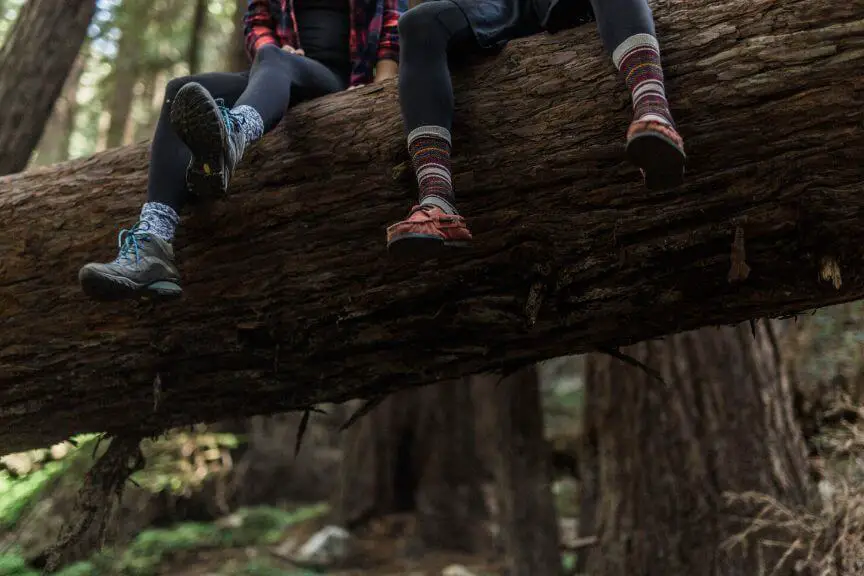Your feet are among the parts of your body that produce the most sweat, and wearing two pairs of socks, especially when hiking, helps absorb excessive sweat.
And if you are an ardent hiker, then you know how uncomfortable sweaty feet can be, and the best way to prevent and manage them is by wearing moisture-wicking hiking socks.
Here’s if you need sock liners for hiking & backpacking
Yes, you do. A socks liner draws moisture from your feet to keep them dry and cool, reducing the amount of friction against your hiking shoe, which would otherwise cause blistering. Some feet sweat more than others, and if yours are, wear a pair of sock liners underneath your thick pair of hiking socks.

More About Socks Liners for Hiking
Some feet sweat more than others, that is a fact, and if yours are and you are wondering how best to manage them, then your best bet is to wear a pair of sock liners underneath your thick pair of hiking socks.
The tricky part is finding the right thickness of sock liners that would go well with your regular hiking socks.
And that is because the wrong combination of the two would make your feet too thick to comfortably fit into your hiking shoes, leaving no room for movement and limiting their moisture-wicking ability, which is a remedy for disaster.
They say prevention is better than cure. Aside from changing your socks regularly to manage sweaty feet, wearing sock liners made from a fabric that can wick moisture better than others is the surest alternative.
But to be fair, sock liners do not work for everyone because some people do not have the same sweaty feet as others and do not need them because many hiking socks today are breathable and dry faster.
What are sock liners?
Sock liners are a highly functional thin pair of hiking socks with varying lengths that are meant to be worn underneath thick hiking socks because they have no cushioning.
But they can also be worn as the main hiking socks during summer.
Most of these socks are made from moisture-wicking and fast-drying fabrics such as wool and bamboo or a blend of several fabrics such as wool, nylon, polyester, spandex, lycra, acrylic, and many more.
When sweat and moisture are pulled from your skin, it is transported to the outer layer of the liner socks. Here, it is subjected to aeration through your hiking socks, shoes, and into the atmosphere.
For this reason, your feet and socks can stay dry all the time.
When choosing liner socks, it is important to get the right fit that snuggles well around your feet and is longer than your thick hiking sock to prevent them from sliding back inside the shoe and causing unnecessary gathering.
Also, it is important to go with the right style suitable for you, as some liner socks have a toe-fit design for better snuggling.
Note that because liner socks are thin, they tend to wear out fast, so be sure to choose a brand of liner socks that offers a good warranty.
What is the purpose of sock liners?
Their main function is to keep the feet dry and cool during hot weather conditions and warm during cold weather conditions.
Feet sweat a lot no matter the weather conditions, and because hiking shoes or boots are insulated, feet are bound to sweat a little more than usual.
When that happens, moisture is trapped inside the shoe, soaking up the feet and making your trekking journey very uncomfortable.
At best, your feet and footwear end up stinking, which is quite embarrassing, and at worst, the feet soften up, rub against the shoe, and are a remedy for blisters.
And it is even more unfortunate if your feet develop a fungal infection caused by too much moisture trapped inside the shoe for far too long.
Sock liners at best eliminate these mishaps and make your hiking experience easy and smooth.
You will not have to worry about stinking feet and footwear, painful blisters, or any fungal infections
See related: Hydropel Replacement To Avoid Blisters When Hiking
Do Sock Liners Prevent Blisters?
Yes, they do, when your feet get soaked in moisture, the skin softens up, and any kind of rubbing against the shoes is more likely to create a blister.
And that is what a good pair of liner or base socks is meant to prevent, build-up of moisture inside the shoe.
Blisters are a hiker’s worst misfortune.
When soft skin rubs against a hard surface (shoe), the skin loosens up and creates a pocket/s for body fluids to fill up.
When the blisters are aired by wearing open shoes, they dry up without much ado, but when you wear shoes, the blisters break and drain the fluid on your socks exposing raw, painful injured skin.
Broken blisters need a quick remedy to dry up and heal; otherwise, they may fester and create a wound.
That is why hikers cannot afford to be careless as far as the right liner socks, hiking socks, and hiking shoes are concerned.
They may make your hiking expedition very painful and regrettable and if you are a new hiker, then you may give up your newfound hobby altogether.
Final Thoughts
Sock liners work, but many modern-day hiking socks can wick moisture on their own without the help of sock liners.
Furthermore, some people’s feet sweat more than others, increasing their need for liner socks.
The important part is to know when to use them because some hiking trails are tougher than others, and one may need to employ more protective gear to be safe and comfortable.

